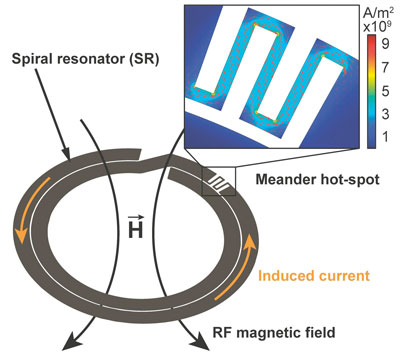| Nov 11, 2019 | |
Biodegradable microresonator implants for medical applications |
|
| (Nanowerk Spotlight) The goal of the electronics industry has always been to build durable devices with stable performance that last a very long time. 'Transient electronics', however, are designed with the exact opposite goal – to dissolve harmlessly into their surroundings after functioning for a predetermined amount of time. | |
| These tiny, fully biocompatible devices promise a generation of medical implants that never need surgical removal and dissolve within the body. This would be ideal for applications such as monitoring and stimulating central and peripheral nervous systems, localized drug delivery, as well as pressure and strain monitoring on tendons during rehabilitation after surgical repair. Transient electronics could also be used as environmental monitors and ecofriendly consumer electronics that can become compost rather than trash. | |
| "The fabrication process and the in vivo powering of medical implants that are only made from biodegradable materials are two of the main challenges associated with transient electronics," Matthieu Rüegg, a PhD student in the Microsystems Laboratory at Ecole Polytechnique Fédérale de Lausanne (EPFL), tells Nanowerk. " Furthermore, since biodegradable materials are water-soluble, the fabrication of such transient devices requires special care and needs to rely solely on dry processing steps without exposure to aqueous solutions." | |
| Rüegg is first author of a paper in Advanced Functional Materials ("Biodegradable Frequency-Selective Magnesium Radio-Frequency Microresonators for Transient Biomedical Implants") that demonstrates wirelessly powered, frequency-selective microstructures as promising candidates to be used as power receiver, microheaters and triggering elements for biodegradable implantable medical devices. | |
| The EPFL team designed and fabricated magnesium microresonators – with a diameter of three millimeters and only two microns thick – with a robust process based on ion beam etching. This technique reduces the devices' exposure to aqueous media without the need to fabricate and use fragile stencils. Finally, a 5 micron thick Parylene passivation layer is deposited on top of the magnesium structures to prevent their degradation in order to study the electronics in aqueous solution over very long periods of time. | |
| In real life applications, the magnesium structures would be passivated by a biodegradable polymer, which degrades over a controlled timescale ranging from from days to months. The degradation rate of this protective passivation layer ultimately defines the degradation rate of the entire device. A stable operation regime during several days or weeks is followed by a rapid degradation of the device functionality within a few minutes (magnesium dissolves in just a few seconds when in contact with an aqueous solution). | |
| According to the researchers, ion beam etching has never before been used to etch magnesium. In addition, the microheaters' spiral design enables the maximization of the capacitance and thus the minimization of the resonance frequency for a given diameter, or, alternatively, the reduction of the size compared to similar devices working in the same frequency range reported in the literature. | |
| By adding a meander to the design, the current density locally increases by one to two orders of magnitude, which creates a local hot spot at a specific location and heats and melts the surrounding environment. This effect could be used, for instance, to melt the outer membrane of an attached capsule with drugs or pain killers with an electromagnetic field sent from outside the body. | |
 |
|
| Design and finite element method (FEM) simulation of a spiral magnesium microresonator with a meander hot spot to increase the induced current density by one to two orders of magnitude. (Reprinted with permission by Wiley-VCH Verlag) | |
| As Rüegg explains, the fabrication consists of four main steps: 1) deposition of a magnesium thin film by thermal evaporation; 2) pattern definition by photolithography; 3) pattern transfer into the magnesium film by ion beam etching; and 4) resist stripping with oxygen plasma and acetone. | |
| "We designed the microheater's shape in order to be able to produce the devices by a single iteration of this 4-step process," he elaborates. "Slightly varying the geometry of the devices in the design process enables the tuning of their resonance frequency and to make them selectively addressable." | |
| The next step for the team will be integrating the resonators into a functional and biodegradable medical device and demonstrate that it is possible to release drugs both in vitro and in vivo. This, of course, will increase the complexity of the fabrication process. | |
| "Indeed, the biodegradable polymers used as structural materials for the final device are sensitive to solvents and temperature, a limitation we will overcome using a microfabrication process based on transfer printing," says Rüegg. | |
 By
Michael
Berger
– Michael is author of three books by the Royal Society of Chemistry:
Nano-Society: Pushing the Boundaries of Technology,
Nanotechnology: The Future is Tiny, and
Nanoengineering: The Skills and Tools Making Technology Invisible
Copyright ©
Nanowerk LLC
By
Michael
Berger
– Michael is author of three books by the Royal Society of Chemistry:
Nano-Society: Pushing the Boundaries of Technology,
Nanotechnology: The Future is Tiny, and
Nanoengineering: The Skills and Tools Making Technology Invisible
Copyright ©
Nanowerk LLC
|
|
|
Become a Spotlight guest author! Join our large and growing group of guest contributors. Have you just published a scientific paper or have other exciting developments to share with the nanotechnology community? Here is how to publish on nanowerk.com. |
|
